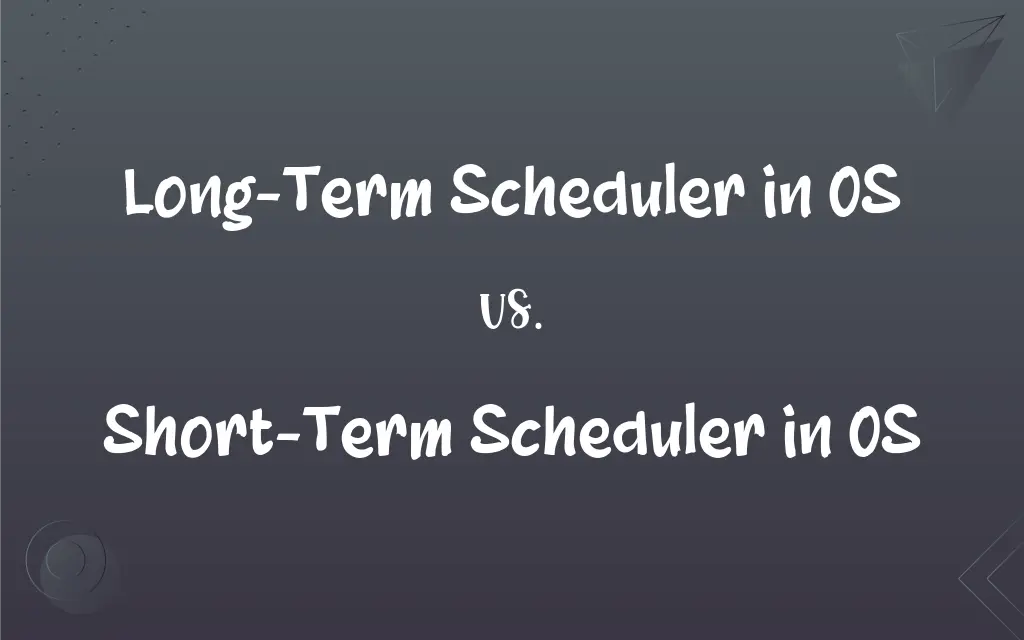Long-Term Scheduler in OS vs. Short-Term Scheduler in OS: What's the Difference?
Edited by Aimie Carlson || By Janet White || Published on February 11, 2024
The long-term scheduler in an OS determines which programs are admitted from the pool for processing, while the short-term scheduler manages which process gets the CPU next.

Key Differences
The long-term scheduler in an operating system is responsible for controlling the admission of jobs into the system. It decides which processes are allowed to enter the ready queue and when they are allowed to do so. This scheduler often works to balance the mix of CPU-bound and I/O-bound processes. On the other hand, the short-term scheduler, also known as the CPU scheduler, operates more frequently. It is responsible for selecting which process in the ready queue should be executed next and allocated CPU time.
In essence, the long-term scheduler in an OS regulates the degree of multiprogramming. It determines how many processes are in the system at any given time, thus affecting the overall system performance and resource utilization. The short-term scheduler, in contrast, is designed to provide efficient and fair CPU allocation to executing processes. It makes rapid decisions and can invoke context switches to ensure that all processes receive adequate CPU time.
The long-term scheduler in an OS is less frequent in its operation compared to the short-term scheduler. It makes relatively infrequent but significant decisions about process admission. Its goal is often to maintain a good process mix for optimal system performance. Conversely, the short-term scheduler operates very frequently, potentially after every time slice in a time-sharing system, making decisions about which process gets to use the CPU next.
The long-term scheduler in an OS plays a critical role in controlling the system's load. It can be adjusted to be more or less aggressive in admitting new processes, thereby managing the system's workload. In contrast, the short-term scheduler is focused on achieving system efficiency and fairness among processes. It is concerned with performance metrics like throughput and response time.
Comparison Chart
Frequency of Operation
Operates infrequently
Operates very frequently
ADVERTISEMENT
Primary Function
Decides which processes enter the ready queue
Selects which process in the ready queue gets CPU next
Impact on System
Controls degree of multiprogramming and system load
Manages CPU allocation for efficiency and fairness
Decision-making Process
Makes significant, less frequent decisions
Makes rapid, frequent decisions
Concern
Balancing mix of CPU-bound and I/O-bound processes
Ensuring adequate CPU time for all processes
Long-Term Scheduler in OS and Short-Term Scheduler in OS Definitions
Long-Term Scheduler in OS
It operates less frequently, making significant decisions about process admission.
The long-term scheduler in the OS infrequently updates its policies to adapt to changing system demands.
ADVERTISEMENT
Short-Term Scheduler in OS
This scheduler operates frequently, managing immediate CPU scheduling decisions.
Due to its frequent operation, the short-term scheduler in the OS rapidly responded to process priorities.
Long-Term Scheduler in OS
The long-term scheduler in an OS determines which processes enter the system for processing.
When the system is overloaded, the long-term scheduler in the OS restricts the admission of new processes.
Short-Term Scheduler in OS
It is focused on efficient and fair CPU allocation.
The short-term scheduler in the OS ensured that each process received an equal amount of CPU time.
Long-Term Scheduler in OS
The long-term scheduler controls the mix of CPU-bound and I/O-bound processes.
To optimize processing, the long-term scheduler in the OS admitted more I/O-bound processes.
Short-Term Scheduler in OS
The short-term scheduler in an OS decides which process in the ready queue gets the CPU next.
The short-term scheduler in the OS quickly switched between processes to maximize CPU usage.
Long-Term Scheduler in OS
It manages the degree of multiprogramming and overall system load.
The long-term scheduler in the OS was adjusted to improve system performance by limiting the number of active processes.
Short-Term Scheduler in OS
The short-term scheduler is crucial for system performance metrics like throughput and response time.
Adjustments to the short-term scheduler in the OS improved the system's overall throughput.
Long-Term Scheduler in OS
The long-term scheduler is responsible for maintaining a balance in system resources.
The long-term scheduler in the OS was revised to prevent resource overutilization.
Short-Term Scheduler in OS
It involves making rapid decisions and potentially invoking context switches.
The short-term scheduler in the OS performed a context switch to allocate CPU time to a higher-priority process.
FAQs
What is the main concern of a long-term scheduler?
Its main concern is balancing the mix of CPU-bound and I/O-bound processes and managing system load.
What is a long-term scheduler in an OS?
It's a component that decides which processes are admitted into the system for processing.
How often does a long-term scheduler operate?
It operates less frequently, making significant but infrequent decisions.
Is the short-term scheduler in an OS frequent in operation?
Yes, it operates very frequently to manage CPU allocation.
Can the long-term scheduler be adjusted?
Yes, it can be adjusted to be more or less aggressive in admitting new processes.
Is the short-term scheduler involved in time-sharing systems?
Yes, it's crucial in time-sharing systems for frequent CPU allocation.
How does the long-term scheduler affect system performance?
It affects system performance by regulating the degree of multiprogramming and system load.
What impact does the short-term scheduler have on system metrics?
It impacts system metrics like throughput and response time.
What does a short-term scheduler do in an OS?
It selects which process in the ready queue gets to use the CPU next.
What does the short-term scheduler focus on?
It focuses on efficient and fair CPU allocation among processes.
What is a critical function of the long-term scheduler in resource management?
Its critical function is to maintain a balance in system resources to prevent overutilization.
Can the short-term scheduler improve system throughput?
Yes, by efficiently allocating CPU time, it can improve system throughput.
Can the long-term scheduler limit process admission?
Yes, it can restrict or allow process admission based on system load.
Does the long-term scheduler manage CPU-bound processes differently?
Yes, it aims to balance CPU-bound and I/O-bound processes for optimal performance.
Is the short-term scheduler customizable in its operation?
Yes, its policies and algorithms can be customized according to system requirements.
How does the short-term scheduler respond to process priorities?
It quickly adjusts CPU allocation based on the priorities of the processes.
Does the short-term scheduler handle context switches?
Yes, it is responsible for managing context switches between processes.
What is the role of the long-term scheduler in multiprogramming?
It controls the degree of multiprogramming by regulating process admission.
How does the short-term scheduler ensure fairness?
It allocates CPU time to processes based on priority or round-robin scheduling for fairness.
How does the long-term scheduler contribute to system stability?
By regulating process admission, it contributes to overall system stability and performance.
About Author
Written by
Janet WhiteJanet White has been an esteemed writer and blogger for Difference Wiki. Holding a Master's degree in Science and Medical Journalism from the prestigious Boston University, she has consistently demonstrated her expertise and passion for her field. When she's not immersed in her work, Janet relishes her time exercising, delving into a good book, and cherishing moments with friends and family.
Edited by
Aimie CarlsonAimie Carlson, holding a master's degree in English literature, is a fervent English language enthusiast. She lends her writing talents to Difference Wiki, a prominent website that specializes in comparisons, offering readers insightful analyses that both captivate and inform.































































